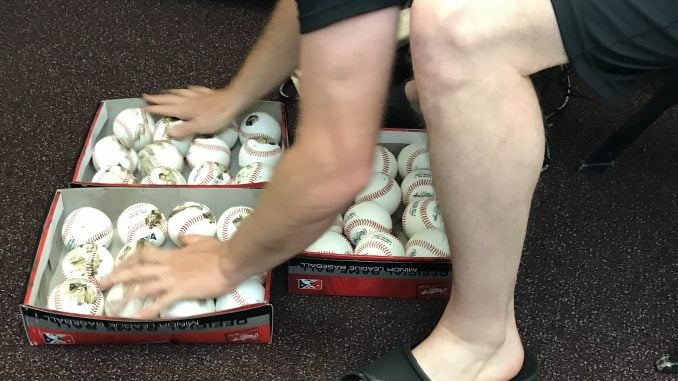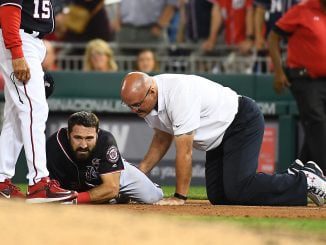
In a small trailer beyond the right-field wall at Zebulon’s Five County Stadium, close enough that batting practice home runs clang off the metal roof, the two umpires for the night’s Carolina Mudcats game sit dipping their hands in a jar of mud.
The same thing is going on simultaneously in dozens of ballparks around the nation, and it will be repeated every night of the summer. And each time, the mud-smeared umps will sit in their shorts and undershirts, preparing for the game.
“Rule No. 1,” says Reed Basner, the senior member of the crew, “is you don’t do this in your good clothes.”
Welcome to the strangest and least-understood ritual in baseball.
***
In the classic movie “Bull Durham,” Crash Davis explained to his teammates what life in The Show is like.

“You never handle your luggage in the show,” Davis said. “Somebody else carries your bags. The ballparks are all cathedrals. You hit white balls for batting practice. The hotels all have room service.”
That’s not entirely true.
At every level of professional baseball, from the low minor leagues up to Fenway and Yankee Stadium, the balls aren’t exactly white.
Oh, they come out of the box white, glistening and shiny new, just like you’d expect a game ball to look. That generally lasts for less than a minute, thanks to the half-naked umps and their mud.
Every ball that a professional pitcher throws — whether in a game, warming up to enter as a reliever, or on an off-day throwing session — is first rubbed with mud to make it easier to grip. The shiny white balls that impressed Davis in the movie were actually smeared with various shades of brown.
Carolina Mudcats pitching coach Bob Milacki opens the wrapper of a Carolina League game ball and hands it to me. “Feel that,” he says. “Try to grip it.”
In order to preserve the leather, baseballs are coated with a gloss before being shipped to teams. It makes the surface of the ball slick to the touch and tough to establish a firm hold with fingertips, let alone direct it to break in a specific direction at 90-plus miles per hour.
The mud removes that glossy coating and makes the ball easier to grip. But not any mud will do. In fact, there’s only one specific mud that has been used by baseball since 1939 — Lena Blackburne’s Baseball Rubbing Mud.
Blackburne, as legend has it, was a player-coach in Philadelphia and happened to live near a small stream that was an offshoot of the Delaware River. The mud at the bottom of that stream was smooth and fine, perfect for removing the shine from a ball without scuffing it.
Since then, his company has provided the mud to all of baseball.
“They’re notoriously tough to deal with,” says Ben Phillips, Basner’s partner in the Carolina League. “They keep the location a secret.”

Over the years, representatives from Lena Blackburne’s Rubbing Mud have told reporters that the mud is harvested by teams of scuba divers, taken blindfolded reporters, one at a time, to the location, only to have the reporters compare notes later on and conclude that they weren’t taken to the same place.
While the location is kept under a veil of mystery, the process of preparing a ball with the mud isn’t so much a secret as entirely up to the user.
“They don’t go over this in umpire school,” says Phillips. “They don’t talk about it at all. You kind of know in the back of your mind you have to do something with it, and then on your first day, they tell you, ‘OK, you have to do this.’”
As a result, each umpire develops his own personal style, at least until they reach the upper levels of the minor leagues and the Majors, where clubhouse attendants treat the balls for them, allowing the umps to keep their hands clean.
Each two-man crew of Carolina League umps is given one jar of rubbing mud at the start of the season and told to make it last.
“That’s a hunny right there,” Basner says as he pulls the jar out of his equipment bag. He’s referring to the price: $100 for a large jar that contains — well, exactly what is advertised on the label.
It’s a jar of mud. Wet, slimy and smelling faintly of rot.
The directions on the jar are deceptively simple: “Apply small amount of mud to palm of hand. Massage onto both palms. Place ball in hand and massage thoroughly. KEEP MOIST.”
Phillips fills the jar’s lid with a small amount of bottled water, which he uses to dilute the pinch of mud he takes from the jar. He then picks up a ball, cradles it in both dirty hands and gives it a firm massage. It takes a few seconds, and he’s on to the next one, running through several cases in a matter of minutes.
His partner, Basner, takes an alternate approach, first misting two open cases of balls with a spray bottle he pulls from his bag. He then puts large globs of mud in each hand and bends forward, smearing the mud across the 24 balls in a scene that would elicit gasps from Crash Davis and the other white-ball purists. He then picks up each filthy ball to rub the mud in, making the ball’s color an even light brown. He learned the method as a rookie ump from his senior partner and has done it that way ever since.
Durham Bulls pitching coach Rick Knapp, who has far fewer balls to do in a day — the umps mud close to 100 for a game, while Knapp might do a dozen for bullpen work — forgoes the water and follows the jar’s instructions to the letter. He has a smaller jar, one that sells for $40 on the company site, and likely has less pressure to make it last the year. So he doesn’t need to dilute it with water.
As the year goes on, the Carolina League umps may find themselves running low, meaning late-season balls may not get quite as much mud as in April and May. And travel mishaps can threaten a crew’s mud supply.
“We’ve left the jar in clubhouses before and had to meet up with other crews to get an emergency supply,” Phillips says. “Just scoop some in a cup, and we’ll try to keep it moist until we get to the next city.”
One legend — Basner won’t name the crew but claims to know their identities — had a pair of umps finding themselves mudless while working in the Northeast.
“We’re not that far from the Delaware River,” one ump said. “That’s where they say it comes from. Mud is mud, right?” A short time later, they were rolling up their pant legs and wading in to harvest their own substitute.
With each umpire figuring out their own style, there is very little consistency from game to game, which can be a source of frustration for pitchers, trying to get a grip, and hitters, who want a nice white target to swing at.
Even among pitchers, the amount of mud makes a difference.
“A pitcher who’s a control guy, grip is going to be really important to him,” Milacki says. “He’ll want to make sure there’s a good amount of mud. The power pitchers on the other hand, they just want to get it and throw it.”
Toss in the fact that clubhouse attendants take over the task at upper levels, and the mud ritual gets even less consistent.
“I can remember there were some places where they seemed to put more mud on than others,” Knapp says. “Cleveland, for whatever reason, their balls always seemed to be dirtier than most.”
It’s an odd, inconsistent, dirty practice, and it may be going away soon. Equipment companies are rumored to be working on a new gloss-free ball, which is supposedly being tested in Japan — although no one spreading the rumor seems to have any concrete details.
Until that happens, fans at stadiums around the country will be watching balls that, if they look closely enough, are just the slightest bit off-white.



